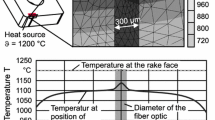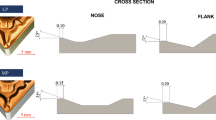Abstract
Abrasive cutting is broadly applied to obtain structural and electromechanical parts for the industry, as well as metallographic specimens for research laboratories. However, the literature about this process is still scarce, making further studies necessary. Usually, the final quality of the obtained products plays a minor role in comparison to the costs associated with tool wear. In this context, an experimental investigation of the abrasive cut-off operation of low and medium carbon steels, using aluminum oxide discs with different feed rates (2.0, 3.4, and 4.6 mm/s), is reported. The cutting power, disc wear, and process temperature were monitored and comprehensively evaluated. Besides, a computational simulation was developed for temperature prediction and the results were compared with the experimental data. The disc surface was assessed through confocal and scanning electron microscopies, and the chips were analyzed with scanning electron microscopy and energy dispersive spectroscopy. Contrary to what was expected, an increase of 130% in feed rate led to a decrease of approximately 57% in maximum temperature, and 84% in diametrical wheel wear, improving process efficiency. On the other hand, the consumed cutting power increased by up to 127%. The proposed simulation model presented a high correlation with the experimental data and can be applied to predict and prevent thermal damages to the parts.












Similar content being viewed by others
References
Vander GF (2012) Applied metallography. Springer Science & Business Media.
Hadad MJ, Tawakoli T, Sadeghi MH, Sadeghi B (2012) Temperature and energy partition in minimum quantity lubrication-MQL grinding process. Int J Mach Tools Manuf 54–55:10–17. https://doi.org/10.1016/j.ijmachtools.2011.11.010
Wang Z, Li Y, Yu T, Zhao J, Wen PH (2019) Prediction of 3D grinding temperature field based on meshless method considering infinite element. Int J Adv Manuf Technol 100:3067–3084. https://doi.org/10.1007/s00170-018-2801-4
Ni J, Yang Y, Wu C (2019) Assessment of water-based fluids with additives in grinding disc cutting process. J Clean Prod 212:593–601. https://doi.org/10.1016/j.jclepro.2018.12.066
Hou ZB, Komanduri R (2004) On the mechanics of the grinding process, part III - thermal analysis of the abrasive cut-off operation. Int J Mach Tools Manuf 44:271–289. https://doi.org/10.1016/j.ijmachtools.2003.09.009
de Martini FL, Lopes JC, Ribeiro FSF et al (2019) Thermal model for surface grinding application. Int J Adv Manuf Technol 104:2783–2793. https://doi.org/10.1007/s00170-019-04101-6
Lopes JC, de Martini FL, Domingues BB et al (2019) Effect of CBN grain friability in hardened steel plunge grinding. Int J Adv Manuf Technol:1567–1577. https://doi.org/10.1007/s00170-019-03654-w
Talon AG, Lopes JC, Tavares AB, Sato BK, Rodrigues AR, Genovez MC, Dinis Pinto TA, de Mello HJ, Aguiar PR, Bianchi EC (2019) Effect of hardened steel grinding using aluminum oxide wheel under application of cutting fluid with corrosion inhibitors. Int J Adv Manuf Technol 104:1437–1448. https://doi.org/10.1007/s00170-019-04005-5
de Mello HJ, de Mello DR, Rodriguez RL, Lopes JC, da Silva RB, de Angelo Sanchez LE, Hildebrandt RA, Aguiar PR, Bianchi EC (2018) Contribution to cylindrical grinding of interrupted surfaces of hardened steel with medium grit wheel. Int J Adv Manuf Technol 95:4049–4057. https://doi.org/10.1007/s00170-017-1552-y
Alexandre FA, Lopes WN, Lofrano Dotto FR, Ferreira FI, Aguiar PR, Bianchi EC, Lopes JC (2018) Tool condition monitoring of aluminum oxide grinding wheel using AE and fuzzy model. Int J Adv Manuf Technol 96:67–79. https://doi.org/10.1007/s00170-018-1582-0
Javaroni RL, Lopes JC, Sato BK et al (2019) Minimum quantity of lubrication (MQL) as an eco-friendly alternative to the cutting fluids in advanced ceramics grinding. Int J Adv Manuf Technol 103. https://doi.org/10.1007/s00170-019-03697-z
Lopes JC, Ventura CEH, de Fernandes ML et al (2019) Application of a wheel cleaning system during grinding of alumina with minimum quantity lubrication. Int J Adv Manuf Technol 102:333–341. https://doi.org/10.1007/s00170-018-3174-4
Lopes JC, Garcia MV, Valentim M, Javaroni RL, Ribeiro FSF, de Angelo Sanchez LE, de Mello HJ, Aguiar PR, Bianchi EC (2019) Grinding performance using variants of the MQL technique: MQL with cooled air and MQL simultaneous to the wheel cleaning jet. Int J Adv Manuf Technol 105:4429–4442. https://doi.org/10.1007/s00170-019-04574-5
Yamasaka M, Fujisawa M, Oku T, Masuda M, Okamura K (1990) Improvement of straightness in precision cut-off grinding using thin diamond wheels. CIRP Ann 39:333–336. https://doi.org/10.1016/S0007-8506(07)61066-X
Araujo LAO, Foschini CR, Jasinevícius RG, Fortulan CA (2016) Precision dicing of hard materials with abrasive blade. Int J Adv Manuf Technol 86:2885–2894. https://doi.org/10.1007/s00170-016-8394-x
Bliznets DA, Bogdanovich PN (2017) Wear of inorganic materials upon wafering using an abrasive tool. J Frict Wear 38:17–22. https://doi.org/10.3103/S1068366616060039
Shaw MC (1975) The rating of abrasive cutoff wheels. J Eng Ind 97:138–146. https://doi.org/10.1115/1.3438526
Eshghy S (1968) Thermal aspects of the abrasive cutoff operation. Part 2—partition functions and optimum cutoff. J Eng Ind v 90:360–364
Hintze W, Klingelhöller C (2017) Analysis and modeling of heat flux into the tool in abrasive circular cutting of unidirectional CFRP. Procedia CIRP 66:210–214. https://doi.org/10.1016/j.procir.2017.03.305
Kaczmarek J (2008) The effect of abrasive cutting on the temperature of grinding wheel and its relative efficiency. Arch Civ Mech Eng 8:81–91. https://doi.org/10.1016/S1644-9665(12)60195-2
Neugebauer R, Hess KU, Gleich S, Pop S (2005) Reducing tool wear in abrasive cutting. Int J Mach Tools Manuf 45:1120–1123. https://doi.org/10.1016/j.ijmachtools.2005.01.002
Pereverzev PP, Pimenov DY (2016) A grinding force model allowing for dulling of abrasive wheel cutting grains in plunge cylindrical grinding. J Frict Wear 37:60–65. https://doi.org/10.3103/S106836661601013X
Bianchi EC, Rodriguez RL, Hildebrandt RA, Lopes JC, de Mello HJ, de Aguiar PR, da Silva RB, Jackson MJ (2019) Application of the auxiliary wheel cleaning jet in the plunge cylindrical grinding with minimum quantity lubrication technique under various flow rates. Proc Inst Mech Eng Part B J Eng Manuf 233:1144–1156. https://doi.org/10.1177/0954405418774599
Agarwal S (2019) On the mechanism and mechanics of wheel loading in grinding. J Manuf Process 41:36–47. https://doi.org/10.1016/j.jmapro.2019.03.009
Lauer-Schmaltz H, König W (1980) Phenomenon of wheel loading mechanisms in grinding. CIRP Ann 29:201–206. https://doi.org/10.1016/S0007-8506(07)61322-5
Khudobin LV, Polyanskov YV (1975) Mechanism of forming and destroying nodes of seizure in metals with abrasive grains during grinding. Sov Mater Sci 9:304–308. https://doi.org/10.1007/BF00722552
Putz M, Cardone M, Dix M (2017) Cut-off grinding of hardened steel wires-modelling of heat distribution. Procedia CIRP 58:67–72. https://doi.org/10.1016/j.procir.2017.03.198
Sahu P, Sagar R (2006) Development of abrasive cut-off wheel having side grooves. Int J Adv Manuf Technol 31:37–40. https://doi.org/10.1007/s00170-005-0138-2
Komanduri R, Hou ZB (2001) A review of the experimental techniques for the measurement of heat and temperatures generated in some manufacturing processes and tribology. Tribol Int 34:653–682. https://doi.org/10.1016/S0301-679X(01)00068-8
Davies MA, Ueda T, M’Saoubi R et al (2007) On the measurement of temperature in material removal processes. CIRP Ann - Manuf Technol 56:581–604. https://doi.org/10.1016/j.cirp.2007.10.009
Bergman TL, Lavine A, Incropera FP, Dewitt DP (2017). Fundamentals of heat and mass transfer (pp. 533–534). New York: John Wiley & Sons
Malkin S, Guo C (2008) Grinding technology: theory and applications of machining with abrasives, 2a edn. Industrial Press Inc, New York
Rodriguez RL, Lopes JC, Hildebrandt RA, Perez RRV, Diniz AE, de Ângelo Sanchez LE, Rodrigues AR, de Mello HJ, de Aguiar PR, Bianchi EC (2019) Evaluation of grinding process using simultaneously MQL technique and cleaning jet on grinding wheel surface. J Mater Process Technol 271:357–367. https://doi.org/10.1016/j.jmatprotec.2019.03.019
Astakhov VP, Outeiro J (2019) Importance of temperature in metal cutting and its proper measurement/modeling. In: Davim JP (ed) measurement in machining and tribology (pp. 1–47). Springer, Cham
Denkena B, Tönshoff HK (2011) Spanen. Springer Berlin Heidelberg, Berlin
Garcia MV, Lopes JC, Diniz AE, Rodrigues AR, Volpato RS, Sanchez LEA, de Mello HJ, Aguiar PR, Bianchi EC (2020) Grinding performance of bearing steel using MQL under different dilutions and wheel cleaning for green manufacture. J Clean Prod 120376:120376. https://doi.org/10.1016/j.jclepro.2020.120376
Setti D, Sinha MK, Ghosh S, Venkateswara Rao P (2015) Performance evaluation of Ti-6Al-4V grinding using chip formation and coefficient of friction under the influence of nanofluids. Int J Mach Tools Manuf 88:237–248. https://doi.org/10.1016/j.ijmachtools.2014.10.005
Su G, Xiao X, Du J et al (2020) On cutting temperatures in high and ultrahigh-speed machining. Int J Adv Manuf Technol 107:73–83. https://doi.org/10.1007/s00170-020-05054-x
Acknowledgments
The authors thank the Norton Company, from Saint Gobain Group, for providing the discs.
Funding
The study was financially supported by the São Paulo Research Foundation (FAPESP – process 2018/22661-2), Coordination for the Improvement of Higher Level Education Personnel (CAPES), and National Council for Scientific and Technological Development (CNPq).
Author information
Authors and Affiliations
Corresponding author
Ethics declarations
Conflict of interests
The authors declare that they have no conflict of interest.
Additional information
Publisher’s note
Springer Nature remains neutral with regard to jurisdictional claims in published maps and institutional affiliations.
Rights and permissions
About this article
Cite this article
Lopes, J.C., Ribeiro, F.S.F., Javaroni, R.L. et al. Mechanical and thermal effects of abrasive cut-off applied in low and medium carbon steels using aluminum oxide cutting disc. Int J Adv Manuf Technol 109, 1319–1331 (2020). https://doi.org/10.1007/s00170-020-05753-5
Received:
Accepted:
Published:
Issue Date:
DOI: https://doi.org/10.1007/s00170-020-05753-5




